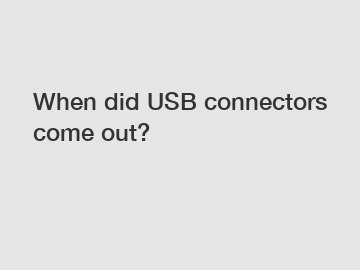When did USB connectors come out?
When did USB connectors come out?
USB connectors have become an indispensable component of our daily lives, enabling us to connect various devices effortlessly. However, have you ever wondered when these innovative connectors first entered the market? In this article, we will delve into the timeline of USB connectors, exploring their origins, advancements, and their profound impact on technology. Let's embark on a journey to uncover the fascinating history of USB connectors.
1. The Birth of USB Connectors:

USB, short for Universal Serial Bus, was developed in the early 1990s by a consortium of seven companies, including Compaq, IBM, Intel, Microsoft, and others. Their collective effort aimed to create a standardized and versatile connector that would simplify device connectivity and reduce compatibility issues. USB 1.0, the first version of USB connectors, was released in 1996.
2. USB 2.0: A Speed Upgrade:
As technology advanced, the need for faster data transfer rates arose. Consequently, USB 2.0 was introduced in 2000, providing significantly enhanced speeds compared to its predecessor. With a top transfer rate of 480 Mbps, USB 2.0 quickly gained popularity as it facilitated swift and efficient communication between devices.
3. USB 3.0: Into the Era of SuperSpeed:
The demand for faster and more efficient data transfer continued to grow, resulting in the emergence of USB 3.0 in 2008. This iteration introduced a new transfer mode called SuperSpeed, offering blazing-fast data transfer rates of up to 5 Gbps. USB 3.0 connectors exhibited notable improvements, reducing file transfer times and enhancing overall user experience.
4. USB-C: A Unified Connector for Modern Devices:
With the rise of smartphones, laptops, and tablets, there was a need for a more universal connector that could handle multiple functions. USB-C, introduced in 2014, brought about a revolution in the realm of connectivity. This small, reversible connector allowed for bidirectional power flow, faster data transfer, and support for other standards like HDMI and DisplayPort.
5. USB 4.0: The Future of Connectivity:
The most recent addition to the USB family is USB 4.0, released in 2019. This iteration builds upon the success of USB-C, further enhancing data transfer speeds and capabilities. USB 4.0 provides a maximum data rate of 40 Gbps, making it ideal for high-bandwidth applications such as video editing, gaming, and more.
In conclusion, USB connectors have come a long way since their inception in the mid-1990s. From the humble beginnings of USB 1.0 to the advanced capabilities of USB 4.0, these connectors have revolutionized the way we connect and interact with devices. With each iteration, USB connectors have consistently provided faster data transfer rates, improved compatibility, and a more streamlined user experience. As technology continues to evolve, we can only anticipate further advancements and innovations in the world of USB connectors. So, the next time you plug in your USB device, take a moment to appreciate the remarkable journey that USB connectors have embarked upon.
For more information, please visit hole waterproof plug, dh aviation, 2 pin power industrial circular connector.


